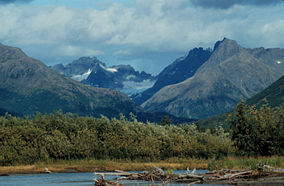Togiak National Wildlife Refuge
| Togiak National Wildlife Refuge | |
|---|---|
|
IUCN category IV (habitat/species management area)
|
|

Ahklun and Wood River Mountains, Togiak National Wildlife Refuge
|
|
| Map of Alaska, United States | |
| Location | Alaska, United States |
| Nearest city | Dillingham, Alaska |
| Coordinates | 59°20′00″N 160°15′02″W / 59.3333333°N 160.2505556°WCoordinates: 59°20′00″N 160°15′02″W / 59.3333333°N 160.2505556°W |
| Area | 4,102,537 acres (16,602.38 km2) |
| Established | 1980 |
| Governing body | U.S. Fish and Wildlife Service |
| Website | Togiak NWR |
Dominated by the Ahklun Mountains in the north and the cold waters of Bristol Bay to the south, Togiak National Wildlife Refuge confronts the traveler with a kaleidoscope of landscapes. The natural forces that have shaped this land range from the violent and powerful to the geologically patient. Earthquakes and volcanoes filled the former role, and their marks can still be found, but it was the gradual advance and retreat of glacial ice that carved many of the physical features of this refuge.
The refuge has a surface area of 4,102,537 acres (16,602.4 km2). It is the fourth-largest National Wildlife Refuge in the United States as well as the state of Alaska, which has all eleven of the largest NWRs.
The refuge is home to 48 mammal species, 31 of which are terrestrial and 17 marine. More than 150,000 caribou from two herds, the Nushagak Peninsula and the Mulchatna, make use of refuge lands, which they share with wolf packs, Alaskan moose, brown and black bears, coyote packs, Canadian lynxes, muskrats, wolverines, two species of fox, marmots, beavers, martens, two species of otter, and porcupines, among other land mammals. Seals, sea lions, walrus and whales are found at various times of year along the refuge's 600 miles (970 km) of coastline.
Within the refuge, the waters produce over 3 million Chinook, sockeye, coho, pink, and chum salmon. Not including the five species of salmon that inhabit the region, there are 27 species found in the waters, including Dolly Varden, Arctic grayling, and rainbow trout. The region's salmon are a primary subsistence source for locals, and provide a very important commercial and recreational fishery.
...
Wikipedia

